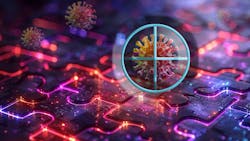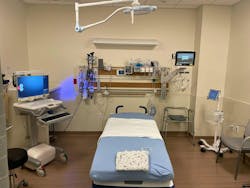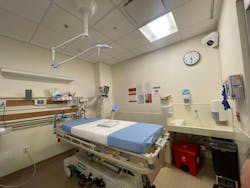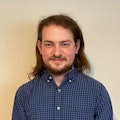Artificial intelligence (AI) has great potential to improve how healthcare workers can assist their patients and prevent the worst outcomes from coming true.
There has been great progress made on the clinician side with AI, but its applications go far beyond that, into the world of sterile processing. New technologies enhanced by AI could provide sterile processing departments with the tools to more precisely and thoroughly sanitize surfaces, objects, and rooms.
One company in the business of AI-enhanced technology is Shyld, whose AI Autonomous UV-C Sanitizer is helping to pave new trails in ultraviolet (UV) disinfection by identifying spaces within rooms in hospitals that are most likely to be carrying pathogens and then focusing their energies on those higher-risk spots. Healthcare Purchasing News was able to speak with Mohammad Noshad, Shyld AI’s co-founder and CEO, about the advances they are making in the space and more broad questions of how AI can potentially prove useful in healthcare settings.
In what spaces is AI technology particularly useful in a healthcare setting?
AI technology can be an engine for accelerated workflow and efficiency, which is most valuable in time-sensitive procedural areas, especially the operating room, where speed of care impacts patient outcomes and every minute gained impacts the bottom line. The Shyld AI Autonomous UV-C Sanitizer is independently proven to inactivate pathogens like MRSA in 10 seconds from 6.5 feet away, which enables heightened pace of care by enabling rapid room turnover in as little as five minutes and even UV-C sanitization between surgeries.
What do AI technologies offer in infection prevention that previous technologies/methods lack?
AI can enable healthcare professionals to identify and target potential risks in real time by delivering precision care and treatment. In the case of environmental hygiene, surfaces, objects, and equipment in dynamic healthcare facilities are sources of continuous contamination and transmission, while current cleaning and disinfection methods are point-in-time and more episodic in application. In addition, as it's impossible to visually see and identify the presence of high-risk pathogens, current environmental hygiene practices focus on disinfecting all surfaces that may pose a risk, which of course takes additional time and resources and may not even compliantly address the present risk. With AI technology, we can enable a precision and targeted approach to identify and inactivate pathogens on surfaces rapidly before they spread. The Shyld AI Autonomous UV-C Sanitizer is equipped with AI technology that monitors the activity in a specific room, identifies contaminated surfaces, then autonomously sanitizes them in seconds without utilizing manual labor.
How does AI enhance UV sanitization?
Specific to UV sanitization, at Shyld AI we're applying advanced AI technology and fully autonomous operation for enhanced efficiency, speed, and effectiveness. First and foremost, with AI and full autonomy, we can eliminate the manual labor required for UV device operation start-to-finish, from finding devices to transporting them and positioning them in rooms. Given the ongoing labor strain healthcare facilities face, this is a fundamental leap forward that frees up busy Environmental Services professionals to focus on the many other tasks of their day. Second, Shyld AI's AI technology enables targeted UV-C sanitization of high-risk surfaces by first identifying specific surfaces and then using a high-performance UV LED beam to sanitize them in as little as 10 seconds. Third, another valuable benefit for healthcare professionals is the Shyld AI device's real-time measurement of the UV-C dose delivered to targeted surfaces. A common question often posed when it comes to UV-C sanitization is, "because UV is invisible, how do I know if it's really working?" With AI technology and advanced sensors, Shyld AI can verify how much UV-C dose has reached any surface in a room, whether at distance or slope to the device. This provides healthcare professionals with real-time assurance the job has been done without guesswork or manual confirmation practices.
What aspects of UV sanitization can still be improved with future AI implementation?
The future is really bright and we're just truly at the edge of realizing what is possible with AI. One innovation that is very exciting is the ability to apply autonomous UV sanitization in occupied spaces, which will be possible with AI technology advancements and even more precise, collimated UV-C beams. There's great potential to integrate many products and services that provide high-performance, effectiveness, and convenience while saving time and labor. Just as we are moving from costly, standalone, isolated devices into integrated devices and assistance at home, the promise of advanced efficiency into healthcare settings is real too.
Has AI eliminated any particularly problematic aspects of UV sanitization?
The most impactful benefit is the elimination of manual labor from UV sanitization. UV devices are extremely valuable and key elements of UV sanitization, yet they can be challenging and time-consuming to operate, limiting their daily use and application. With a fixed, wall-mounted device equipped with AI and advanced sensor technology, Shyld AI powers on and off autonomously, without the need for remote controls, mobile tablets, or smart phone apps. This can enable inflection point efficiency by freeing up labor-stretched teams to perform essential aspects of patient care. We're proud to be part of the next generation of innovation that is realizing the promise of smart healthcare facilities. The future is bright!




